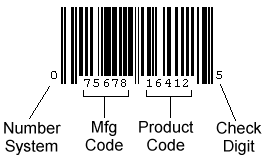What is a UPC-A barcode?
Developed by IBM in 1971, the UPC-A barcode is a subset of the EAN (European Article Numbering ) system. Initially designed for the grocery industry, the UPC-A barcode is found on almost every consumer good packaging today. You can find these barcodes on everything from books, newspapers, and magazines to the shelves of a local supermarket. In the United States, it is also called the standard retail 'price code' barcode. Other names include POS products barcode and consumer goods barcode.
The UPC-A barcode encodes 11 digits of product information data and a trailing check digit for 12 digits of barcode data. The 11 product digits can be divided into three logical categories:
-
The first digit indicates the information regarding the product type.
-
The following five digits include information about the product manufacturer.
- The remaining five digits contain information about the particular product being encoded.
Below is an example of the typical UPC-A barcode is:

Where is a UPC-A used?
The UPC-A barcode is extensively used worldwide for scanning trade items at the POS (point of sale).
Industry
How Dynamsoft help you read UPC-A barcode?
Dynamsoft barcode reader enables you to efficiently embed high-speed and reliable barcode reading functionality in your web, desktop or mobile application using just a few lines of code.
Download the free trial SDK, explore our helpful resource center including sample codes, tutorials, guides and more to get started.
Utilize Dynamsoft Barcode Reader for scanning the challenging UPC-A code effortlessly
Poor Print Quality |
Damaged |
Reflective Surfaces |
Curved Surfaces |

|

|

|

|
Barcode printed with low resolution or smudged ink can add difficulty in scanning. |
Physical damage like scratches, tears, or fading can interfere with the scanner's ability to read the barcode accurately. |
Glossy packaging can cause light reflection, making it difficult for the scanner to read the barcode. |
Barcodes on curved surfaces. like bottles or cans, can be distorted, making them harder to scan. |